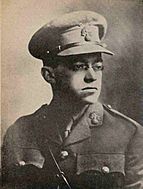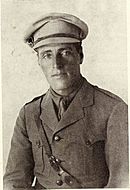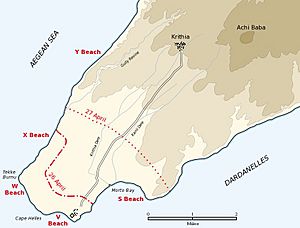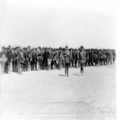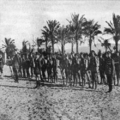Jewish Legion facts for kids
Quick facts for kids Jewish Legion |
|
|---|---|
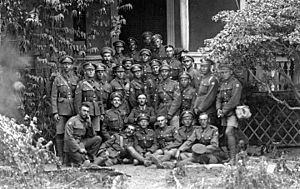
Jewish Legion soldiers in 1919
|
|
| Active | 1917–1921 |
| Country | |
| Allegiance | |
| Branch | |
| Size | 5 battalions |
| Engagements | |
The Jewish Legion was a special group of five battalions within the British Army during World War I. These battalions were made up of Jewish volunteers. They were part of the Royal Fusiliers regiment.
In 1915, the British Army first created the Zion Mule Corps. This was a transportation unit of Jewish volunteers. They helped carry supplies during the Gallipoli campaign. Two years later, in 1917, the British decided to form an infantry battalion of Jewish soldiers.
Because so many Jews volunteered, including many from Russia and the United States, five battalions were formed. These were called the 38th, 39th, 40th, 41st, and 42nd battalions of the Royal Fusiliers. Together, they became known as the "Jewish Legion." The Jewish Legion fought in the Sinai and Palestine campaign. They took part in the important Battle of Megiddo. After the war, the Legion was reduced to one battalion, which was nicknamed the "First Judaeans."
Contents
How the Jewish Legion Began
In 1914, David Ben-Gurion and Yitzhak Ben-Zvi suggested forming a Jewish unit to fight with the Ottoman Army. This idea was approved at first, but then cancelled by Djemal Pasha. Ben-Gurion and Ben-Zvi were among many Jews who were forced to leave the area.
In 1915, two important figures, Zeev Jabotinsky and Joseph Trumpeldor, had a new idea. They wanted to create a military unit from Jewish people who had moved from Palestine to Russia. This unit would help the British take Palestine from the Ottoman Empire. British General Maxwell met with Jabotinsky. The General said he could not enlist foreign people as fighting soldiers. However, he could form them into a volunteer transport unit called the Mule Corps.
Jabotinsky did not like this idea and left to find other support. But Trumpeldor accepted the offer. He began recruiting volunteers from among the Jews in Egypt. The British Army then formed about 650 of these volunteers into the Zion Mule Corps. About 562 of them served in the Gallipoli Campaign.
The Zion Mule Corps at Gallipoli
The Gallipoli peninsula needed a lot of water for the soldiers. So, the Zion Mule Corps was quickly sent there in April 1915. Their commanding officer was Lieutenant-Colonel John Henry Patterson. Captain Trumpeldor was his second-in-command. The Zion Mule Corps landed at Cape Helles between April 27-28. They immediately started carrying supplies.
One soldier, Private M. Groushkowsky, showed great bravery. Near Krithia on May 5, he stopped his mules from running away during heavy bombing. Even though he was wounded, he delivered the ammunition. Trumpeldor was also shot but refused to leave the fight. Colonel Patterson later wrote that many Zionists showed great courage under fire. He said Trumpeldor especially loved being in the thick of the battle.
The men of the Zion Mule Corps returned to Egypt in January 1916. The corps was officially ended in May 1916. Thirteen members of the Zion Mule Corps died during their service.
Forming the Jewish Battalions
After the Zion Mule Corps was disbanded, Jabotinsky, Trumpeldor, and 120 veterans served together. They joined the 16th Platoon of the 20th Battalion, London Regiment.
In August 1917, the British officially announced the creation of a Jewish battalion. This unit was named the 38th Battalion of the Royal Fusiliers. It included British volunteers, former Zion Mule Corps members, and many Russian Jews. In April 1918, the 39th Battalion was added. This battalion was formed in Fort Edward, Canada. It was made up almost entirely of Jews living in the United States and Canada.
Thousands of Palestinian Jews also wanted to join. In 1918, over 1,000 of them were enlisted. Ninety-two Ottoman Jews who had been captured in earlier fighting were also allowed to join. This group formed the 40th Battalion. The 41st and 42nd Battalions were training battalions. They were stationed in Plymouth, England.
Jabotinsky wrote that the 5,000 members of the Legion came from different places. About 34% were from the United States, 30% from Palestine, and 28% from England. Six percent were from Canada, and 1% were Ottoman war prisoners. Another 1% were from Argentina. The 38th, 39th, and 40th Battalions fought in the Jordan Valley. They fought against the Ottomans north of Jerusalem.
Fighting in the Jordan Valley, 1918
In June 1918, the 38th Battalion began fighting the Ottomans about twenty miles north of Jerusalem. In the Jordan Valley, more than twenty Legionnaires were killed, wounded, or captured. Many others got malaria, and thirty of them later died. The 38th Battalion was part of the 31st Brigade of the 10th (Irish) Division. The Legion later came under the command of Major-General Edward Chaytor.
Besides smaller fights, the Legion also took part in the Battle of Megiddo. This battle happened in mid-September 1918. It is seen as one of the final and most important victories on the Ottoman front.
The Legion's main task was to cross the Jordan River. Jabotinsky led this effort. He was later honored for his bravery. General Chaytor told the Jewish troops that by crossing the Jordan River, they greatly helped win the big victory at Damascus.
In August 1919, fifty-six men from the Battalion were put on trial. They had refused to keep guarding prisoners of war in the Egyptian desert. They received sentences of 2 to 7 years of hard labor.
What Happened Next: The Legion's Legacy
| Battalion | Fatalities |
|---|---|
| 38th | 43 |
| 39th | 23 |
| 40th | 12 |
| 42nd | 3 |
| 38th/40th | 9 |
| Transferred from Jewish Legion |
1 |
Most members of the Jewish regiments were released from service right after World War I ended in November 1918. Some went back to their home countries. Others settled in Palestine to help build a Jewish homeland. Among them was David Ben-Gurion, who later became the first Prime Minister of Israel.
In late 1919, the Jewish Legion was reduced to just one battalion. It was called the First Judaeans. This battalion received a special cap badge. It showed a menorah (a seven-branched lampstand) with the Hebrew word קדימה Kadima (meaning "forward") at its base.
Former members of the Legion helped protect Jewish communities during the Riots in Palestine of 1920. These riots led to Jabotinsky's arrest. Two former Legion members were killed with Trumpeldor at Tel Hai. Another former member was killed in Tel Aviv-Yafo during the Jaffa riots of 1921. Some members of the Jewish Legion settled in the villages of Avihayil and Be'er Tuvia. One former member also died serving in the Second World War.
Notable Members of the Jewish Legion
Many important people served in the Jewish Legion:
- John Henry Patterson, who commanded the Zion Mule Corps.
- Colonel Eliezer Margolin, who led the 39th Battalion Royal Fusiliers.
- Gershon Agron, who later became the Mayor of Jerusalem.
- Yitzhak Ben-Zvi, who became the second Israeli President.
- Yaakov Dori, who was the first Chief of Staff of the Israel Defense Forces.
- Sir Jacob Epstein, a famous British sculptor.
- Levi Eshkol, who became the third Prime Minister of Israel.
- David Grün, who later changed his name to Ben-Gurion and became the first Israeli Prime Minister.
- Nachum Gutman, a well-known Israeli painter.
- Dov Hoz, a Zionist activist and fighter for the Haganah.
- James Armand de Rothschild, a major in the 39th Royal Fusiliers Battalion.
- Edwin Herbert Samuel, 2nd Viscount Samuel, whose father was Herbert Samuel, the first British High Commissioner for Palestine.
- Eleazar Sukenik, an Israeli archaeologist.
- David Tidhar, a police officer and author.
Images for kids
-
A recruitment poster showing Daughter of Zion: "Your Old New Land must have you! Join the Jewish regiment."
-
Colonel John Henry Patterson.
-
December 1917. Jewish Legion soldiers at the Western Wall after the British take-over of Jerusalem.
-
Lt. Ze'ev Jabotinsky MBE in uniform of 38th RF (centre seated).
-
39th Battalion, Jewish Legion, at Fort Edward (Nova Scotia), Yom Kippur, 1918.
-
Private Yitzhak Ben-Zvi, a volunteer in the Jewish Legion 1918.
-
Private David Ben-Gurion, a volunteer in the Jewish Legion 1918.
See also
- Jewish Brigade, a similar military group of Jewish volunteers in the British Army during World War II.
- Jewish Legion (Anders Army), a proposed unit in the Polish Army during World War II.
- Tilhas Tizig Gesheften, an organization that grew out of the Jewish Brigade.


